This page has been archived and is being provided for reference purposes only. The page is no longer being updated, and therefore, links on the page may be invalid.
Survey Giant Salvinia with Remote Sensing?
By Marcia Wood
May 6, 2002
Infestations of giant salvinia, one of the world's worst water weeds, might be more easily detected using airborne color-infrared photography.
This fern, known to scientists as Salvinia molesta, forms dense mats in ponds, lakes and reservoirs. The mats use up oxygen that fish, insects and other aquatic dwellers require. They also clog irrigation and electrical-generating systems and snarl swimming, boating and waterskiing.

Click image for caption and other photo information.
Color-infrared photography, taken from aircraft-mounted cameras, is a fast and affordable way to find and monitor the notorious weed. That is according to Agricultural Research Service rangeland scientist James H. Everitt. He is based at the ARS Kika de la Garza Subtropical Agricultural Research Center in Weslaco, Texas. With colleagues from the Texas Parks and Wildlife Department, Everitt tests remote sensing techniques to spot salvinia outbreaks.
In these experiments, Everitt has analyzed color-infrared photographs of salvinia in several lakes and ponds near Liberty and Bridge City in southeast Texas. Color- infrared photography has been used for decades to differentiate among types of vegetation, based on the amount of light that each reflects. But, Everitt and co- researchers are likely the first in the world to use color-infrared photos successfully to observe salvinia outbreaks.
Everitt is currently exploring the possibility of combining color-infrared video--instead of photography--with global positioning and geographic information system technologies. He says the updated package could enable researchers and waterway managers to find giant salvinia outbreaks faster than if they used ground surveys.
ARS is the U.S. Department of Agriculture's chief scientific research agency.
